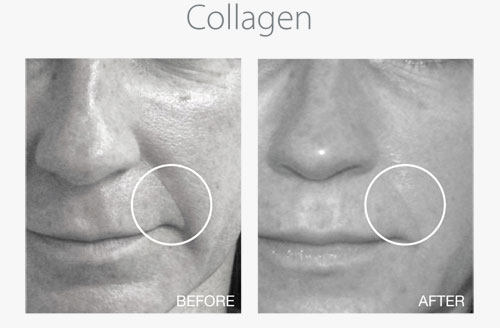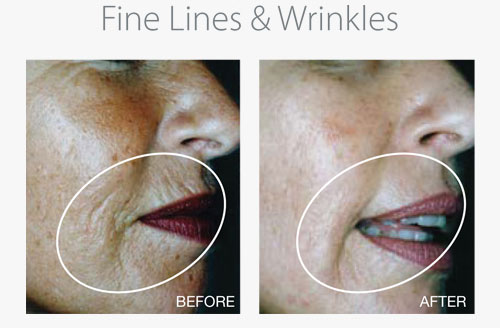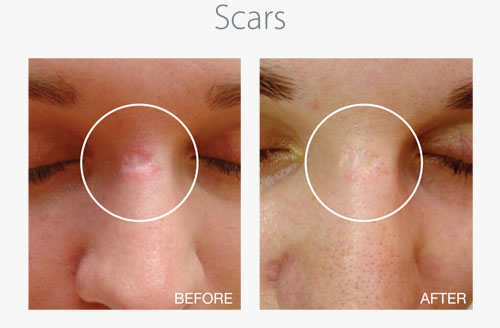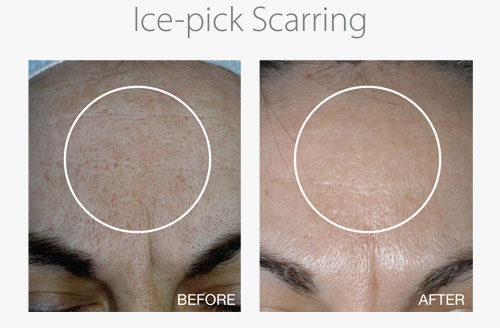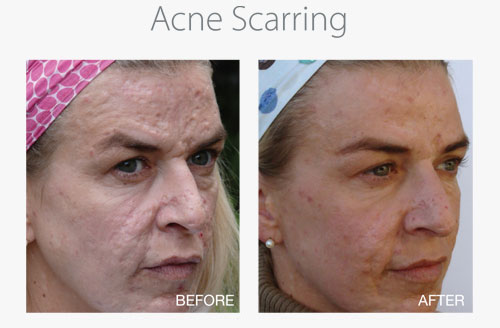Dermaroller-Natural Skin Regeneration
Dermaroller's efficiency has been proven by scientific and clinical findings for anti-ageing, skin regeneration improvement, Scar Reduction Therapy and Collagen Induction Therapy
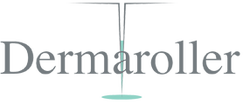
The Dermaroller is an original concept that is German designed & patented device. Dermaroller is the first 'Transdermal Needle Roller' - TGA listed as a Class IIa device. Its efficiency has been proven by scientific and clinical findings for anti-ageing, skin regeneration improvement, Scar Reduction Therapy (SRT) and Collagen Induction Therapy (CIT).
The Dermaroller uses fine, micro-needles to stimulate tissue regeneration. If you suffer from
- Uneven, Dull or Lifeless Skin,
- Wrinkles,
- Open Pores,
- Pigmentation,
- Scarring,
- Stretch Marks or
- Hair loss...
Your solution is Dermaroller
Collagen Induction Therapy
Collagen Induction Therapy Dermaroller™ - Collagen Induction Therapy procedure works by stimulating your own body’s collagen. Your body will start to naturally regenerate the skin, working below the surface in the dermis. New skin cells are generated & blood supply is enhanced. It will only take up to 6 weeks before visible signs of regeneration are seen & the process will continue over the following months, providing you with a gradual & long lasting enhancement.
Scar Reduction Therapy
Scar Reduction Therapy Dermaroller™ - Scar Reduction Therapy procedure works by releasing old fibrotic scar tissue deep within the skin. Scar tissue is what creates visible scars on the skin’s surface. The treatment will repair the skin naturally, working below the surface in the dermis. This takes time as new collagen & elastin fibres are formed, softening scars, generating new skin cells & enhancing blood supply. Results can be seen within 6 weeks, and a total of 70-80% improvement of scars.
Science
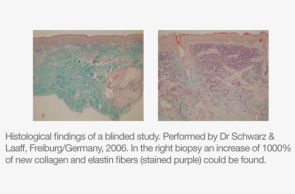
STIMULATION OF CELL GROWTH
Abstract reflections about COLLAGEN-INDUCTION-THERAPY (CIT)
A Hypothesis for the Mechanism of Action of Collagen Induction Therapy (CIT) using Micro-Needles 1st editition February 2006. 2nd revision January 2007
By Horst Liebl
ABSTRACT
The Collagen-Induction-Therapy (CIT) with the needling device called Dermaroller™ is a fairly new procedure for the stimulation of new collagen fibres and other skin cells. In contrary to all ablative techniques such as acid peels or laser it does not damage the skin nor is the epidermis removed. The mechanism of action of the CIT remains largely unknown. If a CIT is performed lege artis I hypothesize that the usual release of growth factors from thrombocytes only play a minor or no role at all.
In 2006, Dr. Laaff, a dermato-pathologist, evaluated 20 blinded biopsies from a study performed by Dr. M. Schwarz, a plastic surgeon from Freiburg, into the effects of the Dermaroller on collagen and elastin formation. Biopsies were taken by Dr Schwarz from various parts of the body of 10 patients undergoing elective cosmetic surgery. A first 'control' biopsy was taken adjacent to the site that was needled with the Dermaroller. Six to eight weeks later, another biopsy was taken from the needled skin. New collagen and elastin fiber formation was obvious and quite dramatic. On average, an increase of new fibers of 206% was observed by the pathologist and in one case a 1,000% increase was recorded. In the absence of any signs of overt tissue damage, a new hypothesis for a possible mechanism of action of CIT is proposed.
Histological Findings, Freiburg/Germany 2006 20 times magnification of tissue cross-sections. Dr. Schwarz & Dr. Laaff
(Collagen fibers are schown in purple)
Although we do not know exactly how the needles of the Dermaroller induce such a dramatic amount of collagen, we have scientific proof that the needling procedure triggers new collagen fibres, new melanocytes, stimulates revascularisation, hair growth (especially in scars), re-pigments stretch marks, fills depressed acne scars, softens scars and so on. Quality needles do not damage the skin in the sense of a classical injury. The pricking channels close within 60 to 90 minutes and infections therefore are unlikely. In contrary to new laser devices such as Fractional Laser Therapy where a laser beam penetrate the skin as much as 600 to 700 µm, the Dermaroller needles induce new cell formation exactly where it is needed, without thermal damage. The Dermaroller and all its therapeutic possibilities are just at the beginning of research.
For further information on the science of Dermaroller – please visit www.dermaroller.de
Abstract reflections about COLLAGEN-INDUCTION-THERAPY (CIT)
A Hypothesis for the Mechanism of Action of Collagen Induction Therapy (CIT) using Micro-Needles 1st editition February 2006. 2nd revision January 2007
By Horst Liebl
ABSTRACT
The Collagen-Induction-Therapy (CIT) with the needling device called Dermaroller™ is a fairly new procedure for the stimulation of new collagen fibres and other skin cells. In contrary to all ablative techniques such as acid peels or laser it does not damage the skin nor is the epidermis removed. The mechanism of action of the CIT remains largely unknown. If a CIT is performed lege artis I hypothesize that the usual release of growth factors from thrombocytes only play a minor or no role at all.
In 2006, Dr. Laaff, a dermato-pathologist, evaluated 20 blinded biopsies from a study performed by Dr. M. Schwarz, a plastic surgeon from Freiburg, into the effects of the Dermaroller on collagen and elastin formation. Biopsies were taken by Dr Schwarz from various parts of the body of 10 patients undergoing elective cosmetic surgery. A first 'control' biopsy was taken adjacent to the site that was needled with the Dermaroller. Six to eight weeks later, another biopsy was taken from the needled skin. New collagen and elastin fiber formation was obvious and quite dramatic. On average, an increase of new fibers of 206% was observed by the pathologist and in one case a 1,000% increase was recorded. In the absence of any signs of overt tissue damage, a new hypothesis for a possible mechanism of action of CIT is proposed.
Histological Findings, Freiburg/Germany 2006 20 times magnification of tissue cross-sections. Dr. Schwarz & Dr. Laaff
(Collagen fibers are schown in purple)
Although we do not know exactly how the needles of the Dermaroller induce such a dramatic amount of collagen, we have scientific proof that the needling procedure triggers new collagen fibres, new melanocytes, stimulates revascularisation, hair growth (especially in scars), re-pigments stretch marks, fills depressed acne scars, softens scars and so on. Quality needles do not damage the skin in the sense of a classical injury. The pricking channels close within 60 to 90 minutes and infections therefore are unlikely. In contrary to new laser devices such as Fractional Laser Therapy where a laser beam penetrate the skin as much as 600 to 700 µm, the Dermaroller needles induce new cell formation exactly where it is needed, without thermal damage. The Dermaroller and all its therapeutic possibilities are just at the beginning of research.
For further information on the science of Dermaroller – please visit www.dermaroller.de
FAQ
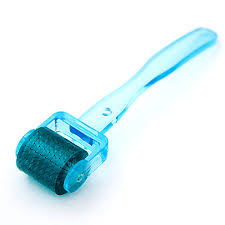
What is the Dermaroller?
The Dermaroller is a cylindrical shaped drum studded with very fine needles. It is a medical device used in micro needling to break down old scar tissue & to stimulate skin cells to proliferate. This cell multiplication results in the formation of new tissue layers of elastin and collagen fibres (neo-collagenesis) as well as in new capillaries for an improved blood supply (neo-angiogenesis). The procedures are called Scar Reduction Therapy (SRT) & Collagen Induction Therapy (CIT).
What is the difference to other skin rejuvenation techniques?
In contrast to all ablative techniques like Lasers and Fractional Laser treatments, the Dermaroller stimulates new tissue formation – it acts constructively and the skin remains intact. The skin does not get damaged (unlike other needling devices) and therefore will not go into a wound healing response. The Dermaroller significantly improves atrophic scars & improves skin texture.
What effects does the Dermaroller have on the skin?
It improves the thickness of the dermis as well as the epidermis. This in return improves skin texture and reduces wrinkles. It also has a positive effect on hyper-pigmentation as well as on hypo-pigmentation. Reduces disfiguring scars & acne scars, stimulates new collagen fibres, improves blood supply and harmonises pigmentation.
How is the procedure performed & does it hurt?
The skin is cleaned and afterwards numbed with an appropriate numbing cream so it should not hurt at all. Skin is thoroughly needled in such a way, that each skin part is needled about 15 to 20 times. An even flushing is the best indication for a perfect medical performance.
Can it be performed on any skin colour?
Since Dermaroller does not use thermal heat (unlike IPL & Lasers) it is safe to use on all skin types and all skin colours. There is no risk of post-inflammatory hyper-pigmentation.
How often can the Dermaroller procedure be repeated?
For Collagen Induction Therapy we recommend to start with 3 treatments, but with a minimum separation time of 6 to 8 weeks between treatments. For Scar Reduction Therapy an average of 3 to 5 treatments are recommended, with an improvement of 70-80%. Unlike ablative procedures for facial skin only, the Dermaroller can be used on all skin parts of the body (neck, décolleté, arms, legs, etc).
What are the side effects of a Dermaroller procedure?
There are virtually no negative side effects, and none have ever been reported in over 150,000 procedures performed worldwide.
Risks of post-op infections?
Since the tiny pricking channels close within one hour, and provided the procedure is done under clinical conditions, post-op infections are very unlikely.
What is the down time after a Dermaroller treatment?
The inflammatory reaction of the skin is extremely short and fades significantly within hours from redness to pinkish that may last for 12 to 24 hours on average. In order to reduce visible redness, we recommend healing minerals, peptides or hyaluronic acid after the procedure, and to protect the skin with zinc based sun screen. We also recommend the use of mineral makeup to help with the healing.
What should I avoid on my skin?
To ensure the right healing environment, for 2-3 days DO NOT use AHA’s (Glycolic Acid), Retinol, acidic or “active” ingredients.
What should I use on my skin after the treatment?
An Anti-Inflammatory Cleanser to soothe, Hyaluronic Acid to hydrate, Copper to help heal, Zinc to help heal but also to protect.
What are the differences in Dermaroller models?
Principally, there are none - both models (medical and home care) only differ in needle size. While the medical Dermaroller has longer needles - to induce collagen & reduce scars in deeper skin layers, the needles of the Home Care Dermaroller are very short, not more than 0.2 mm. The Home Care Dermaroller serves the following purposes:
a) To enhance active substance through the skin barrier(stratum corneum)
b) To improve and support results after and in between CIT treatments by: stimulating epidermal cells for proliferation that results in a faster renewal cycle of the epidermis and thickens the epidermal cell layers.
The Home Care Dermaroller is NOT suitable for collagen treatments, but it helps to maintain a beautiful skin.
Does the Dermaroller have the same effect like Fractional Laser Therapy?
YES! But the mechanism of action of a Fractional Laser is totally different. The laser beam sets a burn wound that results in necrosis. After an inflammatory process the necrosis transforms into fibrotic tissue in forms of micro scars. Nerve cells are “melted” by the hot laser beam, therefore the treatment is relatively painful. As the doctor cannot see the previous set scars under the epidermis in a follow-up treatment, it is extreme difficult for them to set an even scar pattern.
This is the reason why more treatments are required than initially anticipated. But overall, as reported in clinical trials and besides costly investment in lasers, both therapies have about the same results for facial treatments.
Is the Dermaroller TGA listed in Australia?
Definitely YES! To ensure the quality of the device, the Dermaroller is listed on the Australian Register of Therapeutic Goods (ARTG) as a Class IIa medical device. It is the first medical device of its type included on this registe
The Dermaroller is a cylindrical shaped drum studded with very fine needles. It is a medical device used in micro needling to break down old scar tissue & to stimulate skin cells to proliferate. This cell multiplication results in the formation of new tissue layers of elastin and collagen fibres (neo-collagenesis) as well as in new capillaries for an improved blood supply (neo-angiogenesis). The procedures are called Scar Reduction Therapy (SRT) & Collagen Induction Therapy (CIT).
What is the difference to other skin rejuvenation techniques?
In contrast to all ablative techniques like Lasers and Fractional Laser treatments, the Dermaroller stimulates new tissue formation – it acts constructively and the skin remains intact. The skin does not get damaged (unlike other needling devices) and therefore will not go into a wound healing response. The Dermaroller significantly improves atrophic scars & improves skin texture.
What effects does the Dermaroller have on the skin?
It improves the thickness of the dermis as well as the epidermis. This in return improves skin texture and reduces wrinkles. It also has a positive effect on hyper-pigmentation as well as on hypo-pigmentation. Reduces disfiguring scars & acne scars, stimulates new collagen fibres, improves blood supply and harmonises pigmentation.
How is the procedure performed & does it hurt?
The skin is cleaned and afterwards numbed with an appropriate numbing cream so it should not hurt at all. Skin is thoroughly needled in such a way, that each skin part is needled about 15 to 20 times. An even flushing is the best indication for a perfect medical performance.
Can it be performed on any skin colour?
Since Dermaroller does not use thermal heat (unlike IPL & Lasers) it is safe to use on all skin types and all skin colours. There is no risk of post-inflammatory hyper-pigmentation.
How often can the Dermaroller procedure be repeated?
For Collagen Induction Therapy we recommend to start with 3 treatments, but with a minimum separation time of 6 to 8 weeks between treatments. For Scar Reduction Therapy an average of 3 to 5 treatments are recommended, with an improvement of 70-80%. Unlike ablative procedures for facial skin only, the Dermaroller can be used on all skin parts of the body (neck, décolleté, arms, legs, etc).
What are the side effects of a Dermaroller procedure?
There are virtually no negative side effects, and none have ever been reported in over 150,000 procedures performed worldwide.
Risks of post-op infections?
Since the tiny pricking channels close within one hour, and provided the procedure is done under clinical conditions, post-op infections are very unlikely.
What is the down time after a Dermaroller treatment?
The inflammatory reaction of the skin is extremely short and fades significantly within hours from redness to pinkish that may last for 12 to 24 hours on average. In order to reduce visible redness, we recommend healing minerals, peptides or hyaluronic acid after the procedure, and to protect the skin with zinc based sun screen. We also recommend the use of mineral makeup to help with the healing.
What should I avoid on my skin?
To ensure the right healing environment, for 2-3 days DO NOT use AHA’s (Glycolic Acid), Retinol, acidic or “active” ingredients.
What should I use on my skin after the treatment?
An Anti-Inflammatory Cleanser to soothe, Hyaluronic Acid to hydrate, Copper to help heal, Zinc to help heal but also to protect.
What are the differences in Dermaroller models?
Principally, there are none - both models (medical and home care) only differ in needle size. While the medical Dermaroller has longer needles - to induce collagen & reduce scars in deeper skin layers, the needles of the Home Care Dermaroller are very short, not more than 0.2 mm. The Home Care Dermaroller serves the following purposes:
a) To enhance active substance through the skin barrier(stratum corneum)
b) To improve and support results after and in between CIT treatments by: stimulating epidermal cells for proliferation that results in a faster renewal cycle of the epidermis and thickens the epidermal cell layers.
The Home Care Dermaroller is NOT suitable for collagen treatments, but it helps to maintain a beautiful skin.
Does the Dermaroller have the same effect like Fractional Laser Therapy?
YES! But the mechanism of action of a Fractional Laser is totally different. The laser beam sets a burn wound that results in necrosis. After an inflammatory process the necrosis transforms into fibrotic tissue in forms of micro scars. Nerve cells are “melted” by the hot laser beam, therefore the treatment is relatively painful. As the doctor cannot see the previous set scars under the epidermis in a follow-up treatment, it is extreme difficult for them to set an even scar pattern.
This is the reason why more treatments are required than initially anticipated. But overall, as reported in clinical trials and besides costly investment in lasers, both therapies have about the same results for facial treatments.
Is the Dermaroller TGA listed in Australia?
Definitely YES! To ensure the quality of the device, the Dermaroller is listed on the Australian Register of Therapeutic Goods (ARTG) as a Class IIa medical device. It is the first medical device of its type included on this registe
Post Treatment
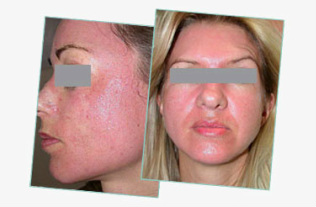
Immediately after your Dermaroller™ treatment you will look as though you have moderate sunburn and your skin may feel warm and tighter than usual. This will start to subside after 1 to 2 hours and will normally recover within the same day with only slight redness the following day.
Your practitioner will prescribe post procedure skincare after the procedure to help soothe, calm and protect the skin. Continue to use for 3 days. Active skincare can be resumed again after day 3.
CLEAN -Use a soothing cleanser / face wash with tepid water to cleanse the face for the following 48 hours and dry gently. Always make sure your hands are clean when touching the treated area.
HEAL – Copper based skincare is recommended post treatment as the mineral properties are prefect to help heal the skin but will also create a sterile skin too.
HYDRATE - Following your Dermaroller™ treatment as the skin may well feel drier than normal. Hyaluronic Acid is an ideal ingredient to hydrate and restore the skin back to a perfect balance.
STIMULATE - In the days following your Dermaroller™ treatment as the skin starts to regenerate, collagen stimulating peptides are ideal to keep the stimulation going.
MAKE-UP - It is recommended that make up is not applied for 12 hours after the procedure although your practitioner may be able to supply you with specialised mineral make-up that they feel would be suitable for use during this period. Do not apply any make up with a make-up brush, especially if it is not clean.
PROTECT - Immediately after the procedure apply a broad spectrum UVA/UVB sunscreen with a SPF30. A chemical free sunscreen is highly recommended.
WHAT TO AVOID -
To ensure the right healing environment, for at least 2 days post treatment, do NOT use any Alpha Hydroxy Acids, Beta Hydroxy Acid, Retinol (Vitamin A), Vitamin C (in a low pH formula) or anything perceived as ‘active’ skincare.
Your practitioner will prescribe post procedure skincare after the procedure to help soothe, calm and protect the skin. Continue to use for 3 days. Active skincare can be resumed again after day 3.
CLEAN -Use a soothing cleanser / face wash with tepid water to cleanse the face for the following 48 hours and dry gently. Always make sure your hands are clean when touching the treated area.
HEAL – Copper based skincare is recommended post treatment as the mineral properties are prefect to help heal the skin but will also create a sterile skin too.
HYDRATE - Following your Dermaroller™ treatment as the skin may well feel drier than normal. Hyaluronic Acid is an ideal ingredient to hydrate and restore the skin back to a perfect balance.
STIMULATE - In the days following your Dermaroller™ treatment as the skin starts to regenerate, collagen stimulating peptides are ideal to keep the stimulation going.
MAKE-UP - It is recommended that make up is not applied for 12 hours after the procedure although your practitioner may be able to supply you with specialised mineral make-up that they feel would be suitable for use during this period. Do not apply any make up with a make-up brush, especially if it is not clean.
PROTECT - Immediately after the procedure apply a broad spectrum UVA/UVB sunscreen with a SPF30. A chemical free sunscreen is highly recommended.
WHAT TO AVOID -
To ensure the right healing environment, for at least 2 days post treatment, do NOT use any Alpha Hydroxy Acids, Beta Hydroxy Acid, Retinol (Vitamin A), Vitamin C (in a low pH formula) or anything perceived as ‘active’ skincare.

